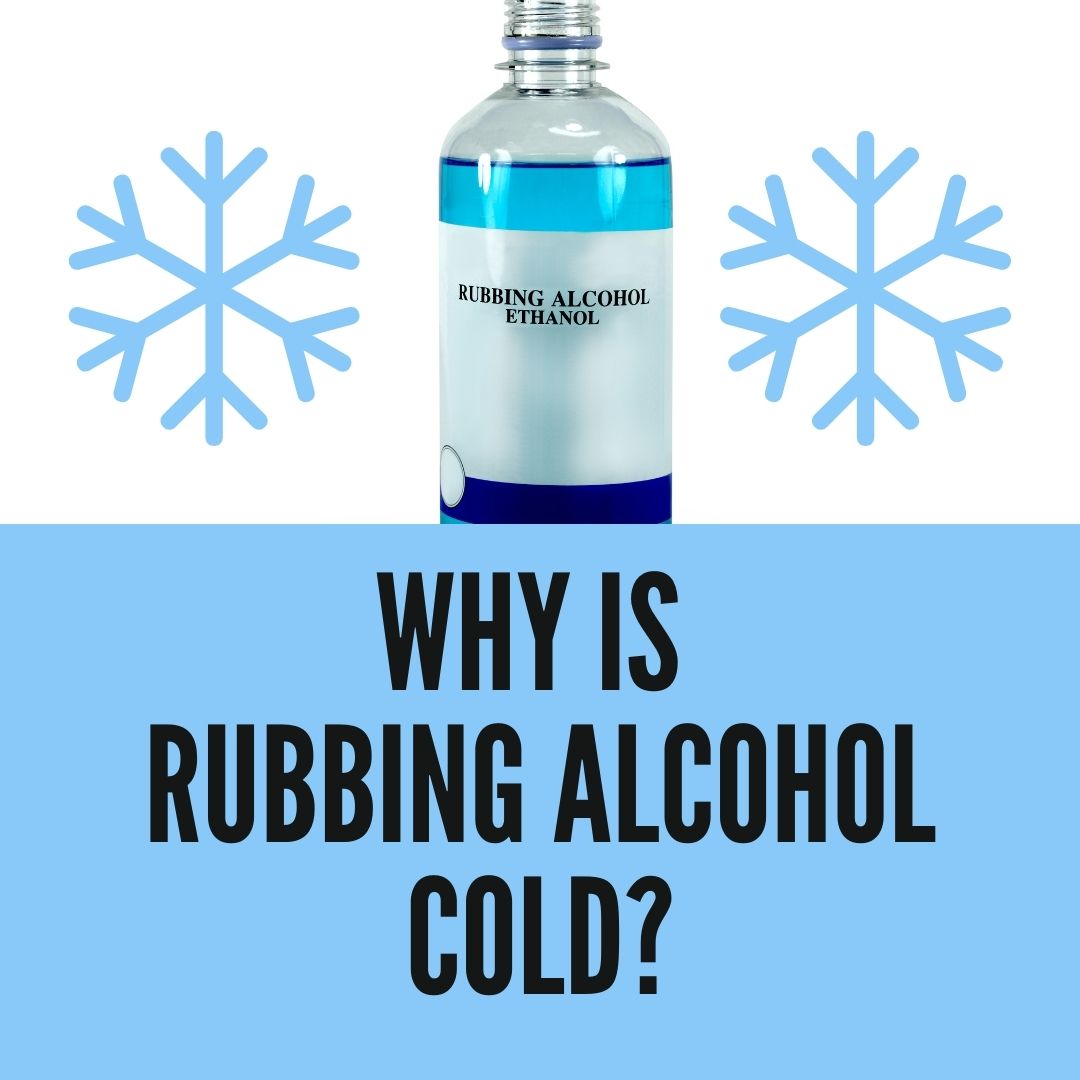
There is something different about how Rubbing Alcohol feels on the skin. If you have ever touched Rubbing Alcohol or used it on your skin, you might have noticed that the solvent feels cold.
Even when you have kept the bottle at room temperature for long, Rubbing Alcohol still leaves that cold effect, similarly to peppermint. But ever wondered why is Rubbing Alcohol Cold? Or why does Rubbing Alcohol lower the temperature of the skin?
If such questions raise your concern, then this article is the end of your research. Why wait then? Let’s get started.
Why does Rubbing Alcohol feel cold?
Rubbing Alcohol as a standalone solvent isn’t cool. However, it is known for its evaporative cooling, which means once the liquid evaporates from your skin, it will leave a cooling after effect.
Let’s understand it with a bit of science:
When an individual sweats, it generates an evaporation process in his body. This process makes the hydrogen bonds break down and absorb thermal energy from the human body.
Now, as the molecules evaporate, they remove heat from the human body, which is known as heat transfer. And when thermal energy leaves your body, the liquid becomes gas, leaving a cooling effect.
But what’s its connection with Rubbing Alcohol?
Rubbing Alcohol, for that matter, evaporate at a very high speed. It happens due to the lower boiling temperature of alcohol. This further initiates heat transfer faster, making it feel cool after the alcohol evaporates. The phenomenon is also known as chilling science.
Can you put Isopropyl in the freezer?
Yes, you can put Isopropyl Alcohol in the freezer, though you may disappoint if you are expecting it to freeze.
Rubbing Alcohol is definitely a liquid that freezes, but for that, it needs a temperature as low as -128 °F (-89 °C). Since home freezers do not have a temperature below 0° F (-18° C),
‘Most possibly’ you won’t be able to freeze Isopropyl with them. However, there are still ways where you can make Isopropyl freeze inside your home refrigerator.
In doing so, Follow Steps Below
- Take a freezing bag, and fill it with 1 part of Isopropyl Alcohol and 3 parts of water.
- Seal the bag and make sure it isn’t full till the neck.
- Now put the bag into your freezer and let it sit for 6 to 8 hours (or whatever time your refrigerator takes to make ice).
In the end, you will get some success; however, due to the presence of Alcohol, the result will still come out malleable.
Does adding Rubbing Alcohol to the water keep it from freezing?
Yes, adding Rubbing Alcohol to water keeps it from freezing. While we mix, Rubbing Alcohol and water, and allow it to freeze, Alcohol keeps water from freezing fully.
Alcohol, though, lowers the temperature for water to freeze; however, it won’t let the process reach its 100% of success. This is also one of the reasons why Rubbing Alcohol comes in handy as an antifreeze solution.
Does Rubbing Alcohol make ice colder?
Yes, Rubbing Alcohol lowers the temperature of ice, making it colder than normal. That is why, for making the coldest ice packs, Rubbing Alcohol is used more commonly.
Also, for most ice commercials, Rubbing Alcohol makes the entire process function easier than if it was done with regular water ice.
Is Rubbing Alcohol flammable?
Rubbing Alcohol, despite its cooling properties, is a highly flammable liquid.
With any source of electricity around, it will not even take a second but catch fire.
It is so dangerous that on catching fire, Rubbing Alcohol can reach a temperature of up to 1000 degrees.
This is almost seven times higher than what can burn through human skin, flesh, and bones.
That is why it is advisable to keep Rubbing Alcohol in well-ventilated and flammable safety cabinets.
Why do your hands get cold after using hand sanitizer?
Alcohol-based hand sanitizers, when evaporates, leave a cooling effect on your hands.
This happens because the particles in gel/ liquid sanitizer allow the higher energy to evaporate from the gel/liquid and from your skin surface.
Its results leave only the particles with low energy levels behind, reducing the overall temperature on your hands.
Or in other words, the quantity of Alcohol vs. Water that evaporates per unit of time leaves a cooling sensation on the skin. For example, it takes longer to evaporate per gram of water than evaporate per gram of Alcohol.
That is why, while water evaporation leaves a little cool sensation on your skin, Alcohol (or sanitizer) evaporation leaves a higher cooling sensation. With its faster evaporation, alcohol takes away much heat from your hands.
Rubbing Alcohol and its Cooling Properties:
Can Rub Alcohol cool down a fever? When treating open cuts and wounds, Rubbing Alcohol may cause a stinging sensation. However, for fever, this solvent contributes to relaxation.
Individuals across the world use Rubbing Alcohol for sponging during high fever. Even though it doesn’t break the fever or help it recover internally, it brings down that extreme temperature for a while.
And when suffering from a high fever, a little drop in temperature too feels very relaxing.
However, the question is, should you really follow Rubbing Alcohol sponging during high fever?
Absolutely not. Rubbing Alcohol sponging during high fever might result in rapid relief from temperature, but it can also prove dangerous. Here are the two prime reasons,
- Rubbing Alcohol with its cooling after effect can bring down body temperature and provide quick relief. However, because it cools skin too quickly, it can also send shivers and chills to the patient’s body. While the fever was already a result of a cold, Rubbing Alcohol’s cooling effect can aggravate the case.
- Secondly, while doing Rubbing Alcohol sponging, there are chances that the patient might inhale it, or alcohol may absorb through the skin. In both conditions, it can lead to accidental Alcohol poisoning in the body. The worst part is that alcohol poisoning can lead to difficulty breathing, Central nervous system depression, and circulatory collapse.
Thus, all in all, regardless of the instant relief a Rubbing Alcohol sponge may provide, avoid practicing it. For some temporary relief, you might end up inviting a hazardous situation.
For treating high temperatures, lukewarm towel sponging or bathing alone can help. Along with that, medicinal guidance from professionals will do the job well.
Where is the best place to store Rubbing Alcohol?
The best way to store Rubbing Alcohol is in a plastic or glass container with a tightly closed lid. Keep the bottle on a dry, cool, and well-ventilated shelf.
While both plastic and glass containers are good to go with Alcohol, avoid transferring the content from its original bottle. This may lead to mistaken consumption as Rubbing Alcohol looks no different from water.
Also, because Rubbing Alcohol evaporates really quickly, make sure the bottle cap is air-tight and nicely closed.
Wrapping up…
Rubbing Alcohol feels cold because of its lower boiling temperature and fast evaporation.
The solution allows more heat to transfer fast, which, when dried, leaves a cooling sensation behind.
Or in terms of Science, Rubbing Alcohol is a volatile liquid. By absorbing latent heat of vaporization it leaves a cooling sensation on the skin.
While wrapping this up, we hope all your queries about Rubbing Alcohol and its cooling properties are now resolved.

My name is Logan, and I’m a 36-year-old dad who owns a small pressure-washing company in the suburbs of Atlanta, Georgia. My main goal with rubbing-alcohol.com is to show you how versatile isopropyl rubbing alcohol can be! I hope. You find it useful.
